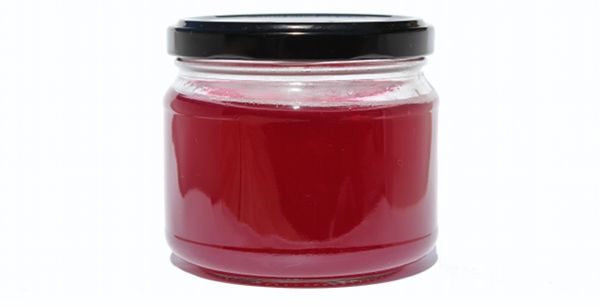When life gives you lemons you make lemonade . Lemons are out of season but my guava tree is laden with fruit and it is easier to pick it off the tree than to deal with the purple mess when the fruit drops to the ground. Hence, guava jelly:

Ingredients
- Guavas, lots in various stages of ripeness.
- Sugar, more than you think. No, even more than that.
- Pectin, don't worry I won't tell
- A Lemon
- You will also need a jelly bag or similar device.
Method
Wash the guavas and remove any stems and leaves. Put the fruit in a large pot with a little water, cover and boil gently until the fruit is all soft and split - about 20 minutes or so. Add more water if required. Make sure all the fruit has opened, you can help things along by mushing it gently with a potato masher, but don't get too vigorous.
Let the mixture cool then pour it carefully into the jelly bag sitting in a large bowl. It is possible to use a pillow case, or even a folded tea towel for this if you don't have a jelly bag - they do the same job. The guavas will turn anything they touch purple but the colour washes out. I wouldn't use my best pillow cases though.
Tie up the jelly bag and hang it over the bowl in an out-of-the-way place for 12 hours. Gravity will force the juice out, leaving the pulp behind. You will feel a strong urge to squeeze the bag - resist temptation! If you force the pulp trough the bag the jelly will become gritty.
Transfer the juice to a pot and bring to the boil. Let the juice boil down a little depending on how strong you want the jelly to taste. Jellies need both sugar and pectin to set properly. Technically the fruit contains enough pectin to set the jelly if you add enough sugar but this has never worked for me. Using store bought pectin ensures a good result and allows you to use less sugar. Even with the extra pectin you still need a lot of sugar - about 3 cups of sugar for every 4 cups of juice should do the trick, depending on the sweetness of the fruit. Pectin also needs an acid to work, so add the juice from the lemon.
Boil the mixture vigorously for a few minutes then boil gently to let the juice reduce for 20-30 minutes. After a while you should see the mixture start to congeal around the edges, this is a sign that the jelly is nearly ready. Use a spoon to skim off the worst of any froth that appears on top of the mixture. Let it boil some more, then pour into pre-heated jars. Hopefully the jelly will set in the follow hours. If not, boil it up some more.
Serve with dark meat or strong cheese.